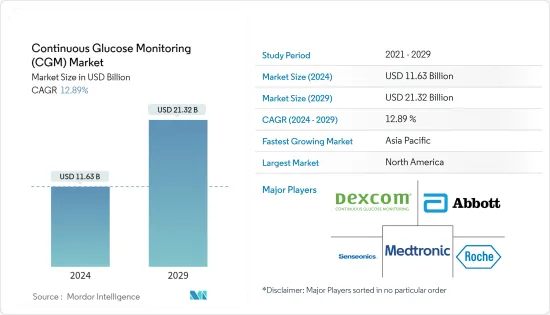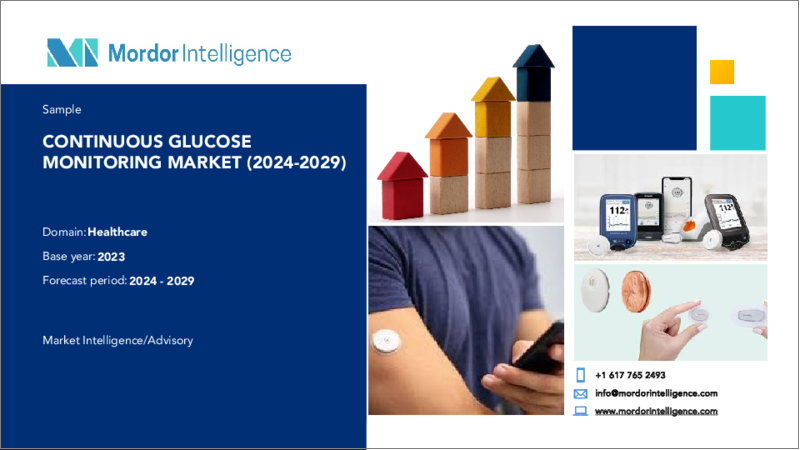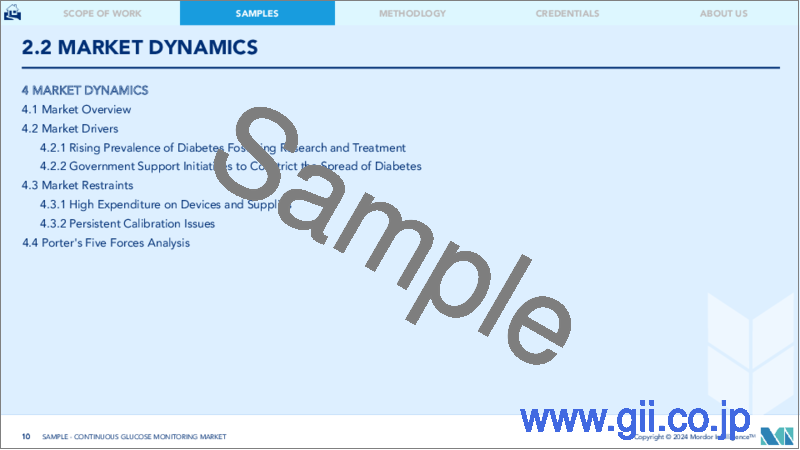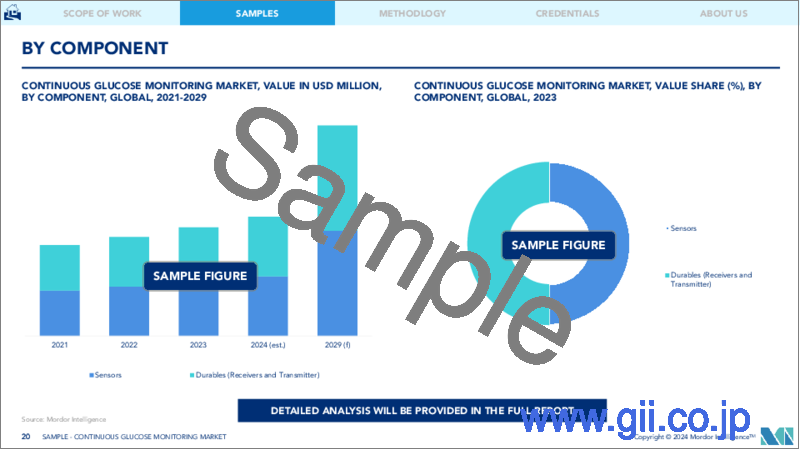|
|
市場調査レポート
商品コード
1536950
持続グルコースモニタリング(CGM)-市場シェア分析、産業動向と統計、成長予測(2024年~2029年)Continuous Glucose Monitoring (CGM) - Market Share Analysis, Industry Trends & Statistics, Growth Forecasts (2024 - 2029) |
||||||
カスタマイズ可能
適宜更新あり
|
|||||||
| 持続グルコースモニタリング(CGM)-市場シェア分析、産業動向と統計、成長予測(2024年~2029年) |
|
出版日: 2024年08月14日
発行: Mordor Intelligence
ページ情報: 英文 118 Pages
納期: 2~3営業日
|
- 全表示
- 概要
- 目次
持続グルコースモニタリング市場規模は2024年に116億3,000万米ドルと推定され、2029年には213億4,000万米ドルに達すると予測され、予測期間中(2024~2029年)のCAGRは12.89%で成長する見込みです。

糖尿病は医療費のかなりの部分を占めています。そのため、疫学調査、治療、予防対策の強化が必要です。様々な企業が、疾病予防と管理をターゲットとしたプログラムを通じて、これらのコストを削減し、人々の健康と幸福の向上に貢献しています。したがって、これらの要因が持続グルコースモニタリング機器市場の成長を促進すると予想されます。糖尿病は、主にライフスタイルの変化に起因して、今後数年間は重大な懸念事項として存続すると予測されています。1型糖尿病は、米国やインドのようないくつかの国では家族歴と強く関連しているが、正確な原因は不明です。1型糖尿病のリスクを高めるのは非修正因子であるが、健康的なライフスタイルを維持することは、糖尿病の症状や長期的な合併症を管理する上で重要です。そのため、糖尿病の有病率は予測期間中に世界的に大きく伸びると予測され、効果的な疾病管理・コントロールのための持続グルコースモニター(CGM)などのモニタリング機器市場を後押ししています。
国際糖尿病連合(IDF)によると、アフリカでは2021年から2045年にかけて糖尿病人口が134%急増すると予測されており、北米とカリブ海諸国では24%の増加が見込まれています。2045年までには、中国が糖尿病罹患者数で世界一になる可能性が高いです。国際糖尿病連合2022年の報告によると、米国の成人の糖尿病有病率は2022年には約11.8%でした。したがって、このような高い有病率は、効果的な疾患制御のための継続的グルコースモニタリング(CGM)デバイスの需要を促進し、それによって予測期間中の市場成長を増強すると予想されます。
持続グルコースモニタリングデバイスは、1型および2型糖尿病患者が少ないフィンガースティック検査で糖尿病を管理するのに役立ちます。これは、アプリを通じてグルコースレベルを追跡するウェアラブル技術デバイスです。ほとんどのCGMデバイスは、一日中5~10分ごとに測定値を取る。CGMデバイスは、センサーから受信機にグルコースデータを転送するためのワイヤレス送信機を持っています。
したがって、糖尿病の有病率の上昇と連続グルコースモニタリングデバイスの需要の高まりは、予測期間にわたって市場の成長を強化すると予想されます。
持続グルコースモニタリング(CGM)市場動向
予測期間中、センサセグメントが主要市場シェアを占める見込み
CGMセンサーは、患者の皮膚の下、通常は腹や腕に埋め込むことができるデバイスで、粘着パッチを使用して所定の位置に固定します。これらのセンサーは1回使い切り用に設計されており、使い捨てセンサーと呼ばれています。
あるいは、埋め込み型センサーとして知られる別のタイプのCGMセンサーもあり、これは患者の体内に挿入することができます。これらのセンサーは、細胞を取り囲む液体中のグルコースレベルを測定し、患者の血液中のグルコースレベルに密接に対応します。センサーの種類にもよるが、数週間ごとなど定期的に交換する必要があります。
持続グルコース・モニタリング・センサ・デバイス市場における新たな技術革新が、市場の成長をさらに後押ししています。例えば、2024年3月、食品医薬品局(FDA)は、Steloとして知られるDexcomの最新の市販型持続グルコースモニターの認可を与えました。この革新的なCGMは、インスリンに頼らない2型糖尿病患者向けに特別に調整されており、この分野における画期的な開発となっています。Steloは、処方箋なしで入手できる初のグルコース・バイオセンサーであり、患者にとってより利用しやすいものとなっています。このグルコース・バイオセンサーは2024年末までに市場に出回ると予想されており、個人はSteloを購入し、その高度な機能の恩恵を受ける機会を得ることになります。
2024年2月、Dexcom ONE+システムはスペイン、ベルギー、ポーランドで利用可能となり、将来的にはオランダや他の欧州諸国でも発売される予定です。一部の地域では、Dexcom ONE+は以前のDexcom ONEセンサーの代わりとなります。Dexcom ONE+は、最も精密なセンサー技術を採用しており、Dexcom ONE+の開発においては、ユーザーと医療専門家の両方からの意見を考慮し、1型または2型糖尿病をインスリンで管理している人々にとって使いやすく、非常に効率的なCGMソリューションを保証しています。
したがって、先進技術を用いたこのようなデバイスの発売は、予測期間中の市場成長を促進する可能性があります。
北米がCGMデバイス市場を独占する見込み
北米は、高度な病院や糖尿病治療施設の広範なネットワークと最先端技術を備えた高度に洗練されたヘルスケアインフラを有しており、持続グルコースモニタリング製品の普及を促進しています。
この地域は、主に糖尿病のような慢性疾患の有病率の上昇に起因して、予測期間中に大きな市場成長が見込まれています。技術的進歩の増加が予測期間中の市場成長を後押しすると予想されます。また、高齢者人口の増加と非侵襲的モニタリングへの注目の高まりも市場成長の原動力となっています。米国では近年、糖尿病の有病率が劇的に増加しています。例えば、国立糖尿病・消化器・腎臓病研究所が2024年1月に発表した報告書によると、2022年、同国では全年齢で3,840万人(人口の11.6%)が糖尿病に罹患していました。そのうち3,810万人が18歳以上の成人です。さらに、2,970万人以上の全年齢層が糖尿病と診断されている(人口の8.9%)。
Diabetes Candaが2023年7月に発表した報告書によると、カナダでは1,190万人以上が糖尿病または糖尿病予備軍と暮らしています。このような糖尿病有病率の上昇は、継続的グルコースモニタリングの需要を生み出し、継続的グルコースモニタリング市場の成長を促進しています。
同市場には、Dexcom社、Abbott社、Signos社、Sensenics Holdings社などの主要企業が進出しており、高い市場シェアを獲得するために常に新しい技術の革新に取り組んでいます。これにより、持続グルコースモニタリング機器の需要が増加し、市場成長が促進されると予想されます。例えば、2024年3月、FDAはDexcom Stelo Glucose Biosensor Systemの販売を許可し、購入可能な最初の店頭(OTC)持続グルコースモニター(CGM)の一つとなった。この装置は2024年夏に発売される予定です。
北米における糖尿病有病率の増加は、継続的グルコースモニタリング市場の大きな成長を促しており、主要企業が継続的に新技術を革新している中、技術の進歩がその原動力となっています。
持続グルコースモニタリング(CGM)産業の概要
持続グルコースモニタリング市場は統合されており、少数の大手企業で構成されています。現在市場を独占している企業には、Dexcom、Abbott、Medtronicがあります。市場の大きなシェアを占めているのは、戦略に基づいたM&Aを並行して行っているCGMメーカーです。これらのメーカーは、新たな収益源を生み出し、既存の収益源を強化するために、常に新たな市場に参入しています。このような市場競争の激化により、各社は自社製品の独自性を確保するため、より新しい技術を試す必要に迫られています。市場競争の意味のひとつは、生産されるCGMユニットの平均販売価格が常に低下することです。各社は技術的ノウハウを高め、製品開発サイクルを早めるために協力しています。
その他の特典:
- エクセル形式の市場予測(ME)シート
- 3ヶ月間のアナリスト・サポート
目次
第1章 イントロダクション
- 調査の前提条件と市場定義
- 調査範囲
第2章 調査手法
第3章 エグゼクティブサマリー
第4章 市場力学
- 市場概要
- 市場促進要因
- 市場抑制要因
- ポーターのファイブフォース分析
- 新規参入業者の脅威
- 買い手・消費者の交渉力
- 供給企業の交渉力
- 代替品の脅威
- 競争企業間の敵対関係の強さ
第5章 市場セグメンテーション
- コンポーネント
- センサー
- 耐久消費財(レシーバーとトランスミッター)
- エンドユーザー
- 病院/家庭
- 家庭/個人
- 地域
- 北米
- 米国
- カナダ
- その他北米
- 欧州
- フランス
- ドイツ
- イタリア
- スペイン
- 英国
- ロシア
- その他欧州
- ラテンアメリカ
- メキシコ
- ブラジル
- その他ラテンアメリカ
- アジア太平洋
- 日本
- 韓国
- 中国
- インド
- オーストラリア
- ベトナム
- マレーシア
- インドネシア
- フィリピン
- タイ
- その他アジア太平洋
- 中東・アフリカ
- サウジアラビア
- イラン
- エジプト
- オマーン
- 南アフリカ
- その他中東とアフリカ
- 北米
第6章 競合情勢
- 企業プロファイル
- Abbott
- Dexcom Inc.
- A. Menarini Diagnostics s.r.l
- Ypsomed Holding AG
- F. Hoffmann-La Roche Ltd
- Medtronic PLC
- Senseonics Holdings Inc.
- Medtrum Technologies
- Nemaura Medical Inc
- i-Sens Inc.
- 企業シェア分析
第7章 市場機会と今後の動向
The Continuous Glucose Monitoring Market size is estimated at USD 11.63 billion in 2024, and is expected to reach USD 21.34 billion by 2029, growing at a CAGR of 12.89% during the forecast period (2024-2029).

Diabetes accounts for a significant portion of healthcare spending. Thus, it requires increased epidemiological surveillance, treatment, and preventive measures. Various companies help reduce these costs and improve the health and well-being of people through programs that target disease prevention and management. Hence, these factors are expected to fuel the growth of the continuous glucose monitoring devices market. Diabetes is anticipated to persist as a significant concern in the coming years, mainly attributed to lifestyle changes. Type 1 diabetes is strongly linked to a family history of the condition in a few countries like the United States and India, but the exact cause is unknown. Nonmodifiable factors increase the risk for type 1 diabetes, though maintaining a healthy lifestyle is important for managing the symptoms and long-term complications associated with the condition. Thus, the prevalence of diabetes globally is projected to experience significant growth during the forecast period, thus boosting the market for monitoring devices such as continuous glucose monitors (CGMs) for effective disease control and management.
As per the International Diabetes Federation (IDF), Africa is projected to witness a 134% surge in the diabetic population from 2021 to 2045, whereas North America and the Caribbean are expected to experience a 24% increase in the disease population. By 2045, China is likely to have the highest number of individuals affected by diabetes globally. According to the International Diabetes Federation 2022 reports, the prevalence of diabetes in adults in the United States was about 11.8% in 2022. Thus, such a high prevalence is expected to drive the demand for continuous glucose monitoring (CGM) devices for effective disease control, thereby augmenting market growth over the forecast period.
Continuous glucose monitoring devices help type1 and type 2 diabetes patients to manage their diabetes with lesser fingerstick tests. It is a wearable technology device to track glucose levels through apps. Most CGM devices take readings every five to ten minutes all day long. CGM devices have a wireless transmitter to transfer the glucose data from the sensor to the receiver.
Therefore, with the rising prevalence of diabetes and the rising demand for continuous glucose monitoring devices is anticipated to bolster the market growth over the forecast period.
Continuous Glucose Monitoring (CGM) Market Trends
The Sensors Segment is Expected to Hold a Major Market Share Over the Forecast Period
The CGM sensor is a device that can be implanted beneath the patient's skin, typically on the belly or arm, using an adhesive patch to secure it in place. These sensors are designed for single-use and are referred to as disposable sensors.
Alternatively, there is another type of CGM sensor known as an implantable sensor, which can be inserted inside the patient's body. These sensors measure the glucose level in the fluid surrounding the cells, which closely corresponds to the glucose level in the patient's blood. Depending on the specific sensor type, they need to be replaced at regular intervals, such as every few weeks.
New innovations in the continuous glucose monitoring sensor devices market are further driving the market growth. For instance, in March 2024, the Food and Drug Administration (FDA) granted clearance for Dexcom's latest over-the-counter continuous glucose monitor, known as Stelo. This innovative CGM is specifically tailored for individuals with type 2 diabetes who do not rely on insulin, making it a groundbreaking development in the field. Stelo is the first glucose biosensor that can be obtained without a prescription, providing greater accessibility for patients. With the glucose biosensor anticipated to hit the market by end of 2024, individuals will have the opportunity to purchase Stelo and benefit from its advanced features.
In February 2024, Dexcom ONE+ system was accessible in Spain, Belgium, and Poland, with plans for a future launch in the Netherlands and other European countries. In certain regions, Dexcom ONE+ will be taking the place of the earlier Dexcom ONE sensor. Dexcom ONE+ utilizes most precise sensor technology company considered input from both users and medical experts during the development of Dexcom ONE+, ensuring a user-friendly and highly efficient CGM solution for individuals managing type 1 or type 2 diabetes with insulin.
Therefore, the launch of such devices using advanced technologies may propel the market growth during the forecast period.
North America is Expected to Dominate the CGM Device Market
North America possesses a highly sophisticated healthcare infrastructure with an extensive network of advanced hospitals and diabetes care facilities well-equipped with cutting-edge technology, facilitating the widespread adoption of continuous glucose monitoring products.
The region is expected to experience significant market growth over the forecast period, mainly attributed to the rising in prevalence of chronic diseases like diabetes. The increase in technological advancements are expected to boost market growth over the forecast period. Market growth is also fueled by the increasing geriatric population and rising focus on non-invasive monitoring. The prevalence of diabetes has increased in the United States dramatically in recent years. For instance, according to a report published by the National Institute of Diabetes and Digestive and Kidney Diseases, in January 2024, in 2022, 38.4 million people of all ages had diabetes (11.6% of the population) in the country. Among these, 38.1 million were adults ages 18 years or older. Moreover, over 29.7 million people of all ages had been diagnosed with diabetes (8.9% of the population).
According to a report published by the Diabetes Canda in July 2023, more than 11.9 million people in Canada living with diabetes or prediabetes. These rising prevalence of diabetes in the country are creating the demand for continuous glucose monitoring, thereby propelling the growth of the continuous glucose monitoring market.
Several key players of the market are present in the country like Dexcom Inc., Abbott, Signos Inc., and Sensenics Holdings Inc., that are constantly working on innovating novel technologies to capture a higher market share. This is expected to increase the demand of continuous glucose monitoring devices, thereby propelling the market growth. For instance, in March 2024, the FDA greenlit marketing for the Dexcom Stelo Glucose Biosensor System, making it one of the first over-the-counter (OTC) continuous glucose monitor (CGM) available for purchase. The device will be available summer 2024.
The increasing prevalence of diabetes in North America is driving significant growth in the continuous glucose monitoring market, fueled by advancements in technology, with key players continually innovating new technologies.
Continuous Glucose Monitoring (CGM) Industry Overview
The continuous glucose monitoring market is consolidated and consists of a few major players. Some companies currently dominating the market are Dexcom, Abbott, and Medtronic. A major share of the market is held by CGM manufacturers that are concurrent with strategy-based M&A operations. They are constantly entering new markets to generate new revenue streams and boost existing ones. These measures taken by the market players will ensure a competitive marketplace, forcing the companies to experiment with newer technologies to ensure uniqueness in their products. One of the implications of the competition in the market is that it will ensure a constant decrease in the average selling price of the CGM units produced. Companies are collaborating to increase their technological know-how and to fasten the product development cycle.
Additional Benefits:
- The market estimate (ME) sheet in Excel format
- 3 months of analyst support
TABLE OF CONTENTS
1 INTRODUCTION
- 1.1 Study Assumptions and Market Definition
- 1.2 Scope of the Study
2 RESEARCH METHODOLOGY
3 EXECUTIVE SUMMARY
4 MARKET DYNAMICS
- 4.1 Market Overview
- 4.2 Market Drivers
- 4.3 Market Restraints
- 4.4 Porter's Five Force Analysis
- 4.4.1 Threat of New Entrants
- 4.4.2 Bargaining Power of Buyers/Consumers
- 4.4.3 Bargaining Power of Suppliers
- 4.4.4 Threat of Substitute Products
- 4.4.5 Intensity of Competitive Rivalry
5 MARKET SEGMENTATION
- 5.1 Component
- 5.1.1 Sensors
- 5.1.2 Durables (Receivers and Transmitter)
- 5.2 End User
- 5.2.1 Hospital/Home
- 5.2.2 Home/Personal
- 5.3 Geography
- 5.3.1 North America
- 5.3.1.1 United States
- 5.3.1.2 Canada
- 5.3.1.3 Rest of North America
- 5.3.2 Europe
- 5.3.2.1 France
- 5.3.2.2 Germany
- 5.3.2.3 Italy
- 5.3.2.4 Spain
- 5.3.2.5 United Kingdom
- 5.3.2.6 Russia
- 5.3.2.7 Rest of Europe
- 5.3.3 Latin America
- 5.3.3.1 Mexico
- 5.3.3.2 Brazil
- 5.3.3.3 Rest of Latin America
- 5.3.4 Asia-Pacific
- 5.3.4.1 Japan
- 5.3.4.2 South Korea
- 5.3.4.3 China
- 5.3.4.4 India
- 5.3.4.5 Australia
- 5.3.4.6 Vietnam
- 5.3.4.7 Malaysia
- 5.3.4.8 Indonesia
- 5.3.4.9 Philippines
- 5.3.4.10 Thailand
- 5.3.4.11 Rest of Asia-Pacific
- 5.3.5 Middle East and Africa
- 5.3.5.1 Saudi Arabia
- 5.3.5.2 Iran
- 5.3.5.3 Egypt
- 5.3.5.4 Oman
- 5.3.5.5 South Africa
- 5.3.5.6 Rest of Middle East and Africa
- 5.3.1 North America
6 COMPETITIVE LANDSCAPE
- 6.1 Company Profiles
- 6.1.1 Abbott
- 6.1.2 Dexcom Inc.
- 6.1.3 A. Menarini Diagnostics s.r.l
- 6.1.4 Ypsomed Holding AG
- 6.1.5 F. Hoffmann-La Roche Ltd
- 6.1.6 Medtronic PLC
- 6.1.7 Senseonics Holdings Inc.
- 6.1.8 Medtrum Technologies
- 6.1.9 Nemaura Medical Inc
- 6.1.10 i-Sens Inc.
- 6.2 Company Share Analysis






